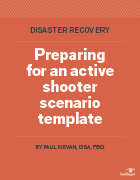
pixel - Fotolia
BC/DR plan template: How to prepare for an active shooter event
A standard BC/DR template typically covers weather, equipment failures and fires. In recent years, more organizations are naming active shooting scenarios as a BC/DR concern.
You might not normally associate a business continuity and disaster recovery plan with an active shooter plan. The former typically is used to keep a business operating during and after an unplanned disruptive event. The latter deals with the sudden and unplanned presence of a person equipped with weapons, such as guns, rifles and knives, who is intent on killing and injuring as many people as possible. Two separate activities with separate players -- that's how they usually appear in an organization. When looking at a general BC/DR plan template, this scenario may not factor in at all.
While weather, geopolitical events and power failures are often considered when crafting a BC/DR plan, organizations may be less focused on active shooter scenarios. However, this is changing. In 2017, respondents to the Business Continuity Institute Horizon Scan Report showed an increasing concern over acts of terrorism over previous reports. These acts can include active shooter scenarios, as well as explosive devices and the use of motor vehicles as weapons.
The following are four business reasons showing how an active shooter program can be a key component in a BC program. We've also included a downloadable, in-depth BC/DR plan template tailored for an active shooter scenario. It is not an event any business wants to have to prepare for, but nonetheless, it is an important aspect of BC that may be overlooked.
Reasons to consider an active shooter program
First, if the outcome of an active shooter event includes any fatalities and/or serious injuries, it could hurt the organization's reputation. Why wasn't the company prepared to handle such an event? Such an event could make existing and potential customers think twice about the company and its ability to protect its employees and guests from such an event.
Second, media coverage of the active shooter event could be damaging to the organization. Without a well-structured response, the media is likely to speculate on the situation and interview people whose opinions could be damaging. The impact could be especially damaging on social media, as information on the event could literally move at the speed of light, generating negative publicity.
Third, an active shooter event could result in legal problems for the company's management. Wrongful death and injury lawsuits are likely to materialize quickly and could be time-consuming and costly to the organization.
Fourth, it may be difficult to attract and hire future employees when there's the perception that the firm's management isn't committed to -- or able to --- protect its employees. Existing employees may consider whether they should remain with the company. These reasons may differ from company to company, so it is important to consider every organization differently when customizing a BC/DR plan template for these scenarios.
Components of an active shooter plan
Now that we've convinced you that an active shooter plan is good business, let's examine the components of an active shooter plan from a business perspective. There are many factors to consider when creating a BC/DR plan for this scenario, so conducting a tabletop exercise (TTX) can be beneficial in running through the process from start to finish. After conducting a TTX, the organization should assess its response and update the plan accordingly.
Most media coverage of active shooter events in recent years has focused on schools, churches and public venues -- places where many people congregate. These are often called soft targets. Active shooter events also occur in businesses -- for example, disgruntled employees who feel a need for some level of revenge or retribution.
Active shooter plans should have a few basic components:
- acknowledging the presence of a shooter;
- locking down the facility to hopefully prevent the shooter from finding more targets;
- communicating with law enforcement agencies, employees and the community;
- getting people into safe locations where the shooter can't find them; and
- initiating recovery from the event.
Recovery following an active shooter event clearly involves more than just traditional DR and will be different for every organization. Along with the included BC/DR plan template, this article should be a start to help you prepare an active shooter plan. Such a plan is an important extension of and enhancement to your BC program. As you progress, update and revise your template, and be sure to check out the various resources provided in our sample template to enhance your plan.







